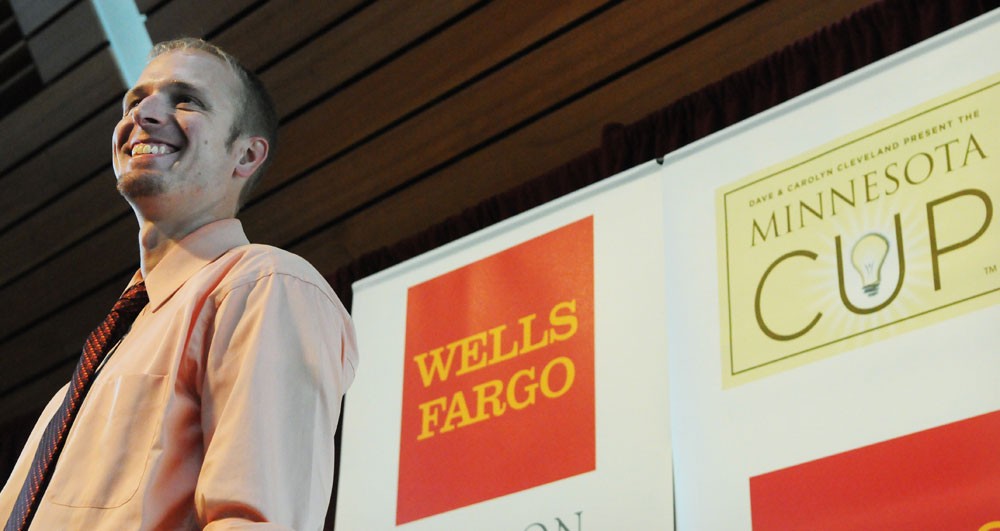Electronic diagnosis of that nagging sinus infection or earache just got a little closer to becoming a viable option for patients. Jonathan Pearce is the founder of Zipnosis, which develops software to facilitate doctor visits online or via cell phone. Pearce, an MBA student at the Carlson School of Management, won the student competition of the fourth annual Minnesota Cup . Winners were announced Thursday during a ceremony at the McNamara Alumni Center. The overall winner of the statewide entrepreneurial competition, Christine Horton of CoreSpine Technologies , will receive $50,000 to develop a spinal surgery device, while Pearce will receive $5,000. The two other student finalists also attend the University. Mechanical engineering graduate student Shyam Sivaramakrishnan applied his research to carbon dioxide sensors to reduce their size and cost. The biggest market for the sensors is in ventilation systems designed to run only when rooms are occupied, he said. Since people exhale carbon dioxide, a roomâÄôs occupancy can be determined by measuring the concentration of this gas in the air. Demand control ventilation, or DCV, can lead to major energy savings and may even help students pay attention during lecture. âÄúWhen you have students dozing off forty minutes into a lecture, this can be due to the increased carbon dioxide level in the room,âÄù Sivaramakrishnan said, adding that DVC could help prevent this by keeping carbon dioxide levels below a certain threshold. His sensors use carbon nanotubes, molecules whose properties change in the presence of carbon dioxide. His innovation lies in the way that the property changes are measured. The exact details of his research could not be revealed because he is still working with the UniversityâÄôs Office of Technology Commercialization to protect the intellectual property. The OTC includes the Licensing Center and the Venture Center , which connects researchers with resources to commercialize their discoveries through licensing or formation of start-ups. Jessica Zeaske , associate director of the Venture Center, said it connects potential start-ups with CEO talent and helps them find management teams and develop business strategy. Mechanical Engineering Associate Professor Rajesh Rajamani , SivaramakrishnanâÄôs adviser, expressed appreciation for the OTC and pointed out that it doesnâÄôt prevent researchers from publishing their findings, but provides guidance if they do want to protect their ideas. Pearce also worked with the Venture Center to develop Zipnosis. The software âÄî which leads users through an âÄúadaptive interviewâÄù where they answer questions designed to glean the information doctors need to diagnose them âÄî was developed with his business partners, both of whom are physicians. The results of the interview are summarized into a clinical note for doctors, who can choose to send a prescription to a pharmacy chosen by the user. Pearce said the software is intended for simple, non-emergency problems like prescription renewals and basic information requests. He said Zipnosis could cover 26 percent of all reasons people go to the doctor. Pearce said recent endorsement of electronic visits by the American Academy of Family Physicians and acceptance on the part of insurance companies opened the door for his innovation. The other student finalist entry was also a software innovation. It came from Brian Limborg , a nutrition science senior, who was fed up with organizational issues, like updating member information and getting business sponsors, that plagued campus groups he was involved with. This frustration led him to develop TreeFortz , a Facebook application for membership organizations. The recently launched software is already being used by a church group and a University of Minnesota, Duluth dance team, said Limborg. All three students said they had benefited from the Minnesota Cup process and expressed interest in continuing down the entrepreneurial path. Pearce said he liked the challenge of it and called it an âÄúaddictive lifestyle.âÄù His advice for aspiring entrepreneurs? âÄúDonâÄôt run with your pants halfway down,âÄù he said, emphasizing the importance of committing completely to pursuing an idea.
Minnesota Cup awards $5,000 to University student

Image by Tara Sloane
University graduate student Jonathan Pearce won the 4th annual Minnesota Cup Student Competition on Thursday at McNamara Alumni Center. His entry, Zipnosis, allows patients and doctors to conduct secure electronic visits.
Published September 12, 2008
0
More to Discover







